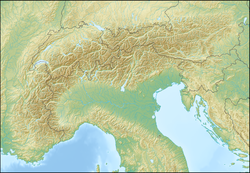The 1348 Friuli earthquake, centered in the South Alpine region of Friuli, was felt across Europe on 25 January. The earthquake hit in the same year that the Great Plague ravaged Italy.[2] According to contemporary sources, it caused considerable damage to structures; churches and houses collapsed, villages were destroyed and foul odors emanated from the earth.[2]
| Local date | 25 January 1348 |
|---|---|
| Magnitude | 6.9-7.1 |
| Epicenter | 46°22′N 13°35′E / 46.37°N 13.58°E |
| Type | Thrust |
| Areas affected | Italy (Friuli-Venezia Giulia) Austria (Carinthia) |
| Max. intensity | MMI X (Extreme)[1] |
| Casualties | 10,000 |
Tectonic setting
editThe Friuli region is located in an area of complex geological structure where the WSW-ENE trending thrust belt of the Southern Alps overlaps with the NW-SE trending thrust belt of the Dinaric Alps as a result of the continuing convergence between the Adriatic and Eurasian plates. It has been suggested that the 1348 event was a result of movement on part of the Periadriatic thrust.[3]
Impact
editThis section needs additional citations for verification. (January 2017) |
The epicenter was located east of Tolmezzo, Venzone and Gemona, with a seismic intensity of eight to nine according to the European Macroseismic Scale (approximately measured 6.9 on the Richter scale). Most of the damage reported was in Northern Italy (including places as far away as Pisa and Naples[2]), in the present-day Friuli-Venezia Giulia region, in the adjacent provinces of Belluno, Vicenza and Verona up to Lombardy and Venice, as well as in Carinthia[4] and Carniola (in nowadays Slovenia) to the north and east. Aftershocks occurred until 5 March.
Striking in the early afternoon, the earthquake caused hundreds of casualties and destroyed numerous buildings. In Udine, the castle and the cathedral were severely damaged. In Carinthia, the town of Villach and numerous surrounding villages were largely destroyed by a major landslide followed by a flood of the Gail River.[4] Even in Rome the earthquake allegedly took a toll: considerable damage was sustained by the Basilica of Santa Maria Maggiore; in the Torre delle Milizie, an upper floor crumbled, and the structure assumed the slight tilt it retains today. The sixth-century basilica of Santi Apostoli was so utterly ruined that it was left in an abandoned state for a generation.
The earthquake coincided with the beginning of the Black Death in Europe; in contemporary minds the two disasters were connected, as acts of God, but accepted as something both tremendous and unexpected, and yet which also belonged to daily life.[4] The historian of medicine A. G. Carmichael observes, "The earthquake of 25 January 1348 is likely to have fuelled and focused specifically apocalyptical fears more than plague did."[5] The only explicit reference to the earthquake as an omen of the end of the world comes in the chronicle of Giovanni Villani. Guglielmo Cortusi of Padua, as well as the bankers of Udine, saw it as a memento mori and a sign to repent, but not of imminent apocalypse.[4] The earthquake figured in the diary of the German nun Christina Ebner, and was reported in numerous city and abbey chronicles, which have given modern historians opportunities of making the "Friuli event" one of the most thoroughly studied medieval earthquakes.
See also
editNotes
edit- ^ National Geophysical Data Center / World Data Service (NGDC/WDS) (1972), Significant Earthquake Information (Data Set), National Geophysical Data Center, NOAA, doi:10.7289/V5TD9V7K
- ^ a b c Kreis, Steven (26 May 2013). "Lecture 29: Satan Triumphant: The Black Death". The History Guide. Archived from the original on 29 May 2013. Retrieved 25 January 2014.
- ^ Galadini F.; Poli M.E.; Zanferrari A. (2005). "Seismogenic sources potentially responsible for earthquakes with M ≥ 6 in the eastern Southern Alps (Thiene-Udine sector, NE Italy)". Geophysical Journal International. 161 (3): 739–762. Bibcode:2005GeoJI.161..739G. doi:10.1111/j.1365-246X.2005.02571.x.
- ^ a b c d Rohr, Christian (May 2003). "Man and natural disaster in the Late Middle Ages: The Earthquake in Carinthia and Northern Italy on 25 January 1348 and its Perception". Environment and History. 9 (2). Cambridge, UK: White Horse Press: 127–149. doi:10.3197/096734003129342791. ISSN 1752-7023. JSTOR 20723281. OCLC 45739177.
- ^ Carmichael, Ann G (January 2008). "Universal and Particular: The Language of Plague, 1348–1500". Medical History. 52 (Supplement S27). London, UK: Wellcome Trust Centre for the History of Medicine provided by Cambridge University Press: 17–52. doi:10.1017/S0025727300072070. OCLC 699570464. PMC 2630032. PMID 18575080.
Further reading
edit- Borst, Arno (December 1981). "Das Erdbeben von 1348: Ein historischer Beitrag zur Katastrophenforschung" [The earthquake of 1348: A historic contribution to disaster research]. Historische Zeitschrift (in German). 233 (3). Munich, Germany: Oldenbourg Wissenschaftsverlag: 529–569. doi:10.1524/hzhz.1981.233.jg.529. ISSN 0018-2613. JSTOR 27622527. OCLC 256491978. S2CID 164347099.
- Hammerl, Christa (1997), The earthquake of January 25, 1348: Reconstruction of a natural occurrence Based on: Hammerl, Christa (1994). "Das Erdbeben vom 25. Jänner 1348. Rekonstruktion des Naturereignisses". Neues aus Alt-Villach. 31. Villach, Austria: Museum der Stadt Villach: 55–94. ISSN 0258-8382. OCLC 231039621, 34621212.
- Gutdeutsch, R.; Lenhardt, W. (9–14 September 1996). "Seismological interpretation of the South Alpine earthquake of January 25th, 1348". In Thorkelsson, Bardi (ed.). Seismology in Europe : papers presented at the XXV General Assembly. 25th ESC General Assembly, Reykjavik, Iceland, 1996. European Seismological Commission. Reykjavik, Iceland: Iceland Meteorological Office. ISBN 997960235X. OCLC 60146813, 730947480, 837306822.
External links
edit- Page on the 1348 Friuli earthquake from the CFTI5 Catalogue of Strong Earthquakes in Italy (461 BC – 1997) and Mediterranean Area (760 BC – 1500) Guidoboni E., Ferrari G., Mariotti D., Comastri A., Tarabusi G., Sgattoni G., Valensise G. (2018) (in Italian)
